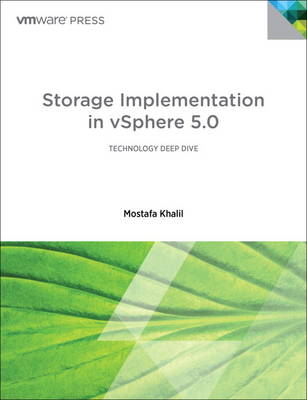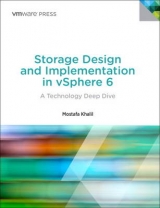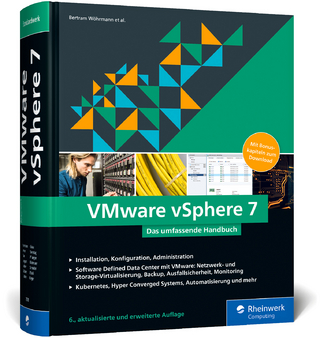
Storage Implementation in vSphere 5.0
VMWare Press (Verlag)
978-0-321-79993-7 (ISBN)
- Titel erscheint in neuer Auflage
- Artikel merken
Effective VMware virtualization storage planning and management has become crucial–but it can be extremely complex. Now, the leading VMware expert on storage completely demystifies the "black box" of vSphere storage and provides illustrated, step-by-step procedures for performing every key task associated with it. You’ll gain the deep understanding you need to make better storage decisions, solve problems, and keep problems from occurring in the first place.
Mostafa Khalil presents techniques based on years of personal experience helping customers troubleshoot storage in their vSphere production environments. With more experience than anyone else in the field, he combines expert guidelines, insights for better architectural design, best practices for both planning and management, common configuration details, and deep dives into both vSphere and third-party storage.
Storage Implementation in vSphere® 5.0 fully explains each storage connectivity choice and protocol supported by VMware, introduces Pluggable Storage Architecture (PSA), and shows how to build on PSA with multipathing, failover, and ALUA. It thoroughly introduces Storage Virtualization Devices (SVDs) and VMDirectPath I/O, and shows how to drive powerful improvements in performance, flexibility, and manageability with VMFS 5 and VAAI.
COVERAGE INCLUDES
Understanding how FC, FCoE, and iSCSI interact with VMware vSphere 5
Implementing specific VMware capabilities on storage hardware from each leading vendor
Avoiding, recognizing, and fixing misconfigurations and other problems
Using third-party MPIO plug-ins certified with vSphere 5 and PSA
Maximizing availability through multipathing and failover
Implementing fixed and round-robin multipathing on arrays with ALUA support
Monitoring and optimizing virtual storage performance
Managing vSphere-compatible file systems: VMFS and NFS
Taking full advantage of VMDirectPath I/O
Implementing heterogeneous storage configurations
Presenting abstracted storage through virtual disks and Raw Device Mappings (RDMs)
Using VMFS 5 to simplify management and improve scalability in large-scale environments
Sharing storage and migrating more easily across multiple VMware vSphere instances
Optimizing storage performance with VAAI-compliant devices
Mostafa Khalil, Senior Staff Engineer with VMware Global Support Services, specializes in storage integration for virtual environments. He has worked for VMware for 13 years and supported all VMware virtualization products since Workstation for Linux 1.0 beta. Khalil has worked on most enterprise storage vendors’ solutions and received engineering-level training for many of them. He has presented at every VMworld, and at VMware Partner Exchange, VMware User Group, and USENIX.
ISBN-13: 978-0-321-79993-7
ISBN-10: 0-321-79993-3
Mostafa Khalil is a senior staff engineer at VMware. He is a senior member of VMware Global Support Services and has worked for VMware for more than 13 years. Prior to joining VMware, he worked at Lotus/IBM. A native of Egypt, Mostafa graduated from the Al-Azhar University’s School of Medicine, and practiced medicine in Cairo. He became intrigued by the mini computer system used in his medical practice and began to educate himself about computing and networking technologies. After moving to the United States, Mostafa continued to focus on computing and acquired several professional certifications. He is certified as VCDX (3, 4, & 5), VCAP (4 & 5)-DCD, VCAP4-DCA, VCP (2, 3, 4, & 5), MCSE, Master CNE, HP ASE, IBM CSE, and Lotus CLP. As storage became a central element in the virtualization environment, Mostafa became an expert in this field and delivered several seminars and troubleshooting workshops at various VMware public events in the United States and around the world.
Part I: Storage Protocols and Block Devices
Chapter 1 Storage Types 1
History of Storage 1
Birth of the Hard Disks 4
Along Comes SCSI 4
PATA and SATA—SCSI’s Distant Cousins? 5
Units of Measuring Storage Capacity 7
Permanent Storage Media Relevant to vSphere 5 8
Chapter 2 Fibre Channel Storage Connectivity 11
SCSI Standards and Protocols 11
SCSI-2 and SCSI-3 Standards 11
Fibre Channel Protocol 12
Decoding EMC Symmetrix WWPN 25
Locating Targets’ WWNN and WWPN Seen by vSphere 5 Hosts 27
SAN Topology 30
Fabric Switches 35
FC Zoning 37
Designing Storage with No Single Points of Failure 41
Chapter 3 FCoE Storage Connectivity 49
FCoE (Fibre Channel over Ethernet) 49 FCoE Initialization Protocol 51
FCoE Initiators 54
Hardware FCoE Adapter 54
Software FCoE Adapter 55
Overcoming Ethernet Limitations 56
Flow Control in FCoE 57
Protocols Required for FCoE 58
Priority-Based Flow Control 58
Enhanced Transmission Selection 58
Data Center Bridging Exchange 59
10GigE — A Large Pipeline 59
802.1p Tag 60
Hardware FCoE Adapters 62
How SW FCoE Is Implemented in ESXi 5 62
Configuring FCoE Network Connections 64
Enabling Software FCoE Adapter 68
Removing or Disabling a Software FCoE Adapter 71
Using the UI to Remove the SW FCoE Adapter 71
Using the CLI to Remove the SW FCoE Adapter 72
Troubleshooting FCoE 73
ESXCLI 73
FCoE-Related Logs 76
Parting Tips 82
Chapter 4 iSCSI Storage Connectivity 85
iSCSI Protocol 85
Chapter 5 vSphere Pluggable Storage Architecture (PSA) 165
Native Multipathing 166
Storage Array Type Plug-in (SATP) 167
How to List SATPs on an ESXi 5 Host 168
Path Selection Plugin (PSP) 169
How to List PSPs on an ESXi 5 Host 170
Third-Party Plug-ins 171
Multipathing Plugins (MPPs) 172
Anatomy of PSA Components 173
I/O Flow Through PSA and NMP 174
Classification of Arrays Based on How They Handle I/O 175
Paths and Path States 176
Preferred Path Setting 176
Flow of I/O Through NMP 178
Listing Multipath Details 179
Listing Paths to a LUN Using the UI 179
Listing Paths to a LUN Using the Command-Line Interface (CLI) 183
Identifying Path States and on Which Path the I/O Is Sent—FC 186
Example of Listing Paths to an iSCSI-Attached Device 187
Identifying Path States and on Which Path the I/O Is Sent—iSCSI 190
Example of Listing Paths to an FCoE-Attached Device 190
Identifying Path States and on Which Path the I/O Is Sent—FC 192
Claim Rules 192
MP Claim Rules 193
Plug-in Registration 196
SATP Claim Rules 197
Modifying PSA Plug-in Configurations Using the UI 201
Which PSA Configurations Can Be Modified Using the UI? 202
Modifying PSA Plug-ins Using the CLI 204
Available CLI Tools and Their Options 204
Adding a PSA Claim Rule 206
How to Delete a Claim Rule 215
How to Mask Paths to a Certain LUN 217
How to Unmask a LUN 219
Changing PSP Assignment via the CLI 220
Chapter 6 ALUA 227
ALUA Definition 228 ALUA Target Port Group 228
Asymmetric Access State 229
ALUA Management Modes 231
ALUA Followover 232
Identifying Device ALUA Configuration 237
Troubleshooting ALUA 243
Chapter 7 Multipathing and Failover 249
What Is a Path? 250
Where Is the Active Path? 255
Identifying the Current Path Using the CLI 255
Identifying the IO (Current) Path Using the UI 256
LUN Discovery and Path Enumeration 258
Sample LUN Discovery and Path Enumeration Log Entries 261
Factors Affecting Multipathing 265
How to Access Advanced Options 266
Failover Triggers 267
SCSI Sense Codes 267
Multipathing Failover Triggers 270
Path States 273
Factors Affecting Paths States 274
Path Selection Plug-ins 276
VMW_PSP_FIXED 276
VMW_PSP_MRU 277
VMW_PSP_RR 277
When and How to Change the Default PSP 277
When Should You Change the Default PSP? 277
How to Change the Default PSP 278
PDL and APD 280
Unmounting a VMFS Volume 281
Detaching the Device Whose Datastore Was Unmounted 286
Path Ranking 291
Path Ranking for ALUA and Non-ALUA Storage 291
How Does Path Ranking Work for ALUA Arrays? 292
How Does Path Ranking Work for Non-ALUA Arrays? 293
Configuring Ranked Paths 295
Chapter 8 Third-Party Multipathing I/O Plug-ins 297
MPIO Implementations on vSphere 5 297 EMC PowerPath/VE 5.7 298
Downloading PowerPath/VE 298
Downloading Relevant PowerPath/VE Documentations 300
PowerPath/VE Installation Overview 302
What Gets Installed? 303
Installation Using the Local CLI 304
Installation Using vMA 5.0 306
Verifying Installation 307
Listing Devices Claimed by PowerPath/VE 311
Managing PowerPath/VE 312
How to Uninstall PowerPath/VE 313
Hitachi Dynamic Link Manager (HDLM) 315
Obtaining Installation Files 316
Installing HDLM 317
Modifying HDLM PSP Assignments 322
Locating Certified Storage on VMware HCL 326
Dell EqualLogic PSP Routed 327
Downloading Documentation 328
Downloading the Installation File and the Setup Script 328
How Does It Work? 328
Installing EQL MEM on vSphere 5 329
Uninstalling Dell PSP EQL ROUTED MEM 331
Chapter 9 Using Heterogeneous Storage Configurations 333
What Is a “Heterogeneous” Storage Environment? 333
Scenarios of Heterogeneous Storage 334
ESXi 5 View of Heterogeneous Storage 335
Basic Rules of Using Heterogeneous Storage 335
Naming Convention 336
So, How Does This All Fit Together? 337
Chapter 10 Using VMDirectPath I/O 345
What Is VMDirectPath? 345 Which I/O Devices Are Supported? 346
Locating Hosts Supporting VMDirectPath IO on the HCL 348
VMDirectPath I/O Configuration 349
What Gets Added to the VM’s Configuration File? 358
Practical Examples of VM Design Scenarios Utilizing VMDirectPath I/O 358
HP Command View EVA Scenario 358
Passing Through Physical Tape Devices 360
What About vmDirectPath Gen. 2? 360
How Does SR-IOV Work? 361
Supported VMDirectPath I/O Devices 364
Example of DirectPath IO Gen. 2 364
Troubleshooting VMDirectPath I/O 364
Interrupt Handling and IRQ Sharing 364
Device Sharing 365
Chapter 11 Storage Virtualization Devices (SVDs) 369
SVD Concept 369
How Does It Work? 370
Constraints 372
Front-End Design Choices 373
Back-End Design Choices 376
LUN Presentation Considerations 377
RDM (RAW Device Mapping) Considerations 378
Part II: File Systems
Chapter 12 VMFS Architecture 381
History of VMFS 382 VMFS 3 on Disk Layout 384
VMFS5 Layout 391
Common Causes of Partition Table Problems 398
Re-creating a Lost Partition Table for VMFS3 Datastores 399
Re-creating a Lost Partition Table for VMFS5 Datastores 404
Preparing for the Worst! Can You Recover from a File System Corruption? 410
Span or Grow? 416
Upgrading to VMFS5 430
Chapter 13 Virtual Disks and RDMs 437
The Big Picture 437
Virtual Disks 438
Virtual Disk Types 441
Thin on Thin 443
Virtual Disk Modes 444
Creating Virtual Disks Using the UI 445
Creating Virtual Disks During VM Creation 445
Creating a Virtual Disk After VM Creation 448
Creating Virtual Disks Using vmkfstools 450
Creating a Zeroed Thick Virtual Disk Using vmkfstools 452
Creating an Eager Zeroed Thick Virtual Disk Using vmkfstools 452
Creating a Thin Virtual Disk Using vmkfstools 454
Cloning Virtual Disks Using vmkfstools 456
Raw Device Mappings 459
Creating Virtual Mode RDMs Using the UI 459
Listing RDM Properties 466
Virtual Storage Adapters 472
Selecting the Type of Virtual Storage Adapter 473
VMware Paravirtual SCSI Controller 475
Virtual Machine Snapshots 477
Creating the VM’s First Snapshot While VM Is Powered Off 478
Creating a VM Second Snapshot While Powered On 484
Snapshot Operations 488
Go to a Snapshot Operation 489
Delete a Snapshot Operation 492
Consolidate Snapshots Operation 494
Reverting to Snapshot 499
Linked Clones 501
Chapter 14 Distributed Locks 505
Basic Locking 506 What Happens When a Host Crashes? 507
Optimistic Locking 508
Dynamic Resource Allocation 509
SAN Aware Retries 509
Optimistic I/O 511
List of Operations That Require SCSI Reservations 511
MSCS-Related SCSI Reservations 512
Perennial Reservations 514
Under the Hood of Distributed Locks 519
Chapter 15 Snapshot Handling 529
What Is a Snapshot? 530
What Is a Replica? 530
What Is a Mirror? 530
VMFS Signature 531
Listing Datastores’ UUIDs via the Command-Line Interface 532
Effects of Snapshots on VMFS Signature 532
How to Handle VMFS Datastore on Snapshot LUNs 533
Resignature 534
Resignature a VMFS Datastore Using the UI 534
Resignature a VMFS Datastore Using ESXCLI 536
Force Mount 540
Force-Mounting VMFS Snapshot Using ESXCLI 541
Sample Script to Force-Mount All Snapshots on Hosts in a Cluster 543
Chapter 16 VAAI 549
What Is VAAI? 550 VAAI Primitives 550
Hardware Acceleration APIs 550
Thin Provisioning APIs 551
Full Copy Primitive (XCOPY) 551
Block Zeroing Primitive (WRITE_SAME) 552
Hardware Accelerated Locking Primitive (ATS) 553
ATS Enhancements on VMFS5 553
Thin Provisioned APIs 554
NAS VAAI Primitives 555
Enabling and Disabling Primitives 555
Disabling Block Device Primitives Using the UI 557
Disabling Block Device VAAI Primitives Using the CLI 559
Disabling the UNMAP Primitive Using the CLI 562
Disabling NAS VAAI Primitives 562
VAAI Plug-ins and VAAI Filter 564
Locating Supported VAAI-Capable Block Devices 565
Locating Supported VAAI-Capable NAS Devices 567
Listing Registered Filter and VAAI Plug-ins 569
Listing VAAI Filters and Plug-ins Configuration 570
Listing VAAI vmkernel Modules 573
Identifying VAAI Primitives Supported by a Device 574
Listing Block Device VAAI Support Status Using the CLI 574
Listing NAS Device VAAI Support Status 577
Listing VAAI Support Status Using the UI 577
Displaying Block Device VAAI I/O Stats Using ESXTOP 579
The VAAI T10 Standard Commands 582
Troubleshooting VAAI Primitives 583
Index 587
| Erscheint lt. Verlag | 6.9.2012 |
|---|---|
| Verlagsort | NJ |
| Sprache | englisch |
| Maße | 179 x 232 mm |
| Gewicht | 1000 g |
| Themenwelt | Informatik ► Betriebssysteme / Server ► Virtualisierung |
| Mathematik / Informatik ► Informatik ► Netzwerke | |
| ISBN-10 | 0-321-79993-3 / 0321799933 |
| ISBN-13 | 978-0-321-79993-7 / 9780321799937 |
| Zustand | Neuware |
| Haben Sie eine Frage zum Produkt? |
aus dem Bereich



